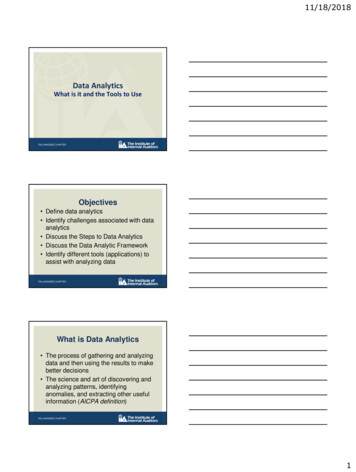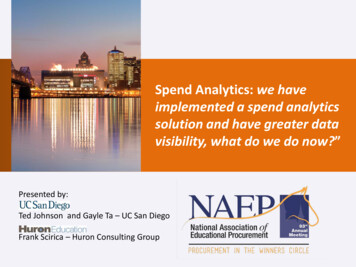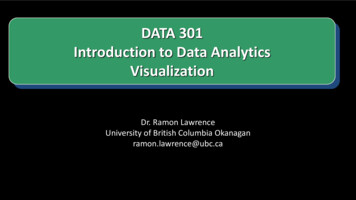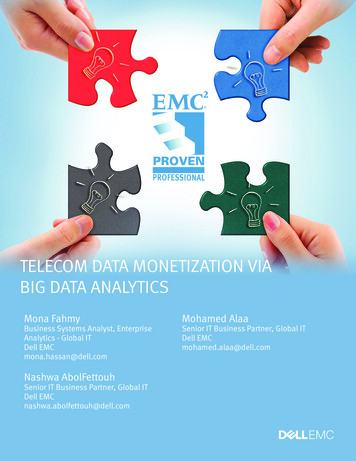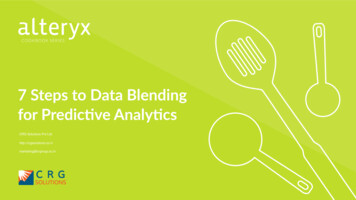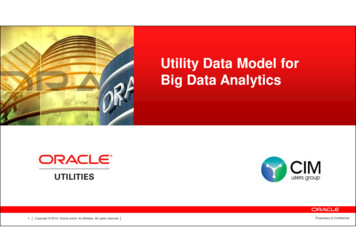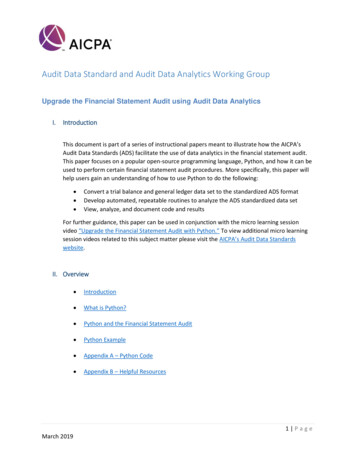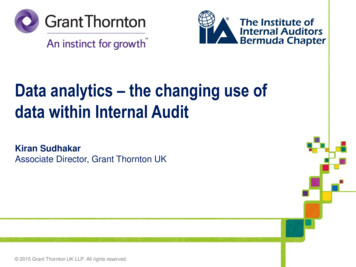
Transcription
Data analytics – the changing use ofdata within Internal AuditKiran SudhakarAssociate Director, Grant Thornton UK 2015 Grant Thornton UK LLP. All rights reserved.
Data analytics – changing use of data in InternalAuditOverviewAreas of discussion IntroductionCommon questions askedEvolution of data analyticsData analytics and the changing landscapeWhat does this mean for internal audit (IA) and riskFuture data driven worldHow we meet the future data driven worldAdditional challengesStages of data analytics maturityIA data analytics spectrumUsing data analytics through your lifecycleSame value .increasing complexitySurvey responses and questionsData visualisation and business intelligenceQuestions and answers 2015 Grant Thornton UK LLP. All rights reserved.There are three kinds oflies: lies, damned lies, andstatisticsMark TwainSimple liars, damned liars,and expertsThomas HenryHuxley
Data analytics – changing use of data in InternalAuditIntroductionKiran SudhakarAssociate Director, Grant Thornton UK Worked for GT for c.8 years with over 15 years specialising in technology and business riskFocus is on enabling technology to enhance business process, risk and control objectives from an internal audit and riskperspectiveMain focus on the Insurance and Banking sectors especially with regards to data interrogation and analysis within theFinancial Crime and trading perspectivePerformed various Solvency II data analysis, interrogation and remediation reviews across the Lloyds' of London marketConducted a number of reviews over the role of Internal Audit within a Three Lines of Defence perspective and the use ofdata to support all lines and provide insight to management and Audit CommitteesPrevious roles includes working in risk assurance positions at Deloitte and PwCHistorically setup a web 2.0 social networking business utilising bleeding edge technologies and approachesData evangelist of using data visualisation to enable a more effective decision making process and prevent bad decisionsfrom bad or sub-optimal data 2015 Grant Thornton UK LLP. All rights reserved.
Data analytics – changing use of data in InternalAuditHow can Imaximise theincreased onuson three lines ofdefence and theincreasing desirefor internal auditinsight?What do we do inorder to meet thechanging regulatoryrequirements andappeasing multipleregulatory regimes? 2015 Grant Thornton UK LLP. All rights reserved.How do weunderstand thechangingcurrent andemerging risksthat we see?Continueddynamicaudit plans– can youquantify it oronly 'feel' it?More auditsand eitherless budgetor thesame .how?How do I make suremy audit and auditorsare only focussing onthe right things? Howdoes data analyticsassist this?How to meetthe increasingrequirement toquantify issues?Managementhas seen thephrase bigdata andwants me toapply it. How?
Data analytics – changing use of data in InternalAuditEvolution of data analytics 2015 Grant Thornton UK LLP. All rights reserved.
Data analytics – changing use of data in InternalAuditData analytics the changing landscapeFrom 2001 and the 3 V's to nowSource: IBMSource: CapGemini 2015 Grant Thornton UK LLP. All rights reserved.
Data analytics – changing use of data in InternalAuditWhat does this mean for IA & Risk?Interesting use ofinfographics by SAP . 2015 Grant Thornton UK LLP. All rights reserved.
Data analytics – changing use of data in InternalAuditWhat does this mean for IA & Risk?More infographics byPwC Canada . 2015 Grant Thornton UK LLP. All rights reserved.
Data analytics – changing use of data in InternalAuditFuture data driven world An on-demand data driven enterprise where data analytics is at the core of allservices and functions (both customer and corporate)Corporate growth considerations will be driven by data not by 'feeling the market' orsample based market researchYour data could be your only IP in a cloud computing worldSerious mistakes could be made on misinterpretation of dataReal/in-time analytics with open source systems may fragment organisations into anecosystem of joint venturesMore and more data due to the cost of data storage and analysis getting cheaper bythe day 2015 Grant Thornton UK LLP. All rights reserved.
Data analytics – changing use of data in InternalAuditHow we meet the future data driven worldChallengeAn on-demand data driven enterprise where dataanalytics is at core of all services and functionsCorporate growth considerations will be data driven by'feeling the market' or sample based market researchYour data could be your only IP in a cloud computingworldSerious mistakes could be made on interpretation ofdataReal time analytics may fragment organisations into anecosystem of joint venturesMore and more data due to the cost of data storageand analysis getting cheaper by the day 2015 Grant Thornton UK LLP. All rights reserved.Internal Audit responseThe need for specialist technology resource to meetthe data demandsRobust processes around business strategies with afocus on validating large data setsInformation security becomes critical, accountingtreatment of IP important and data integrityReputational risk approaches more time sensitiveand more onus on testing of data strategiesLegal risks of ownership and recourse and onus onMI across all business performance (internal/JV)Assessing risks of external/cloud storage andavailability considerations of using bleeding edge IT
Data analytics – changing use of data in InternalAuditAdditional challenges How do you weave in continuous monitoring and sustainable analytics into theInternal Audit fabric?While you may have data evangelists at management level does that apply for theAudit CommitteeSome people just want numbers on a table not visualisationWhere do you start? So much data .IT don't pass me the data to interrogate and analyse in a timely mannerA slow start loses stakeholder enthusiasmMoving between descriptive, predictive to prescriptive analytics is too utopianIs prescriptive analytics the role of IA and risk?Do I recreate analytics or utilise someone else's business intelligence and analysisframework?Where do I find the staff to do this? 2015 Grant Thornton UK LLP. All rights reserved.
Data analytics – changing use of data in InternalAuditStages of data analytics maturityIncreasing adoption andperhaps use of IDEA/ACL.Some value but not integratedwith other data andunpredictable results. A valueadd to the audit not expected.Ad-hocUtilised when needed butlimited to select individualswith limited use of toolsperhaps Excel. No agreedapproach or linkage to otherdata sets.On request data sources inplace and skillset starting to beembedded within thedepartment. Equally reliance oncontinuous monitoring in 2nd lineevolving to form combined view.LimitedandvaluedLimitedvalueAnalytics policy andmethodology and in the 'drivingseat' at the testing stage tovalidate controls. Wider usagewithin Internal Audit and valueseen by stakeholders. 2015 Grant Thornton UK LLP. All rights reserved.MeshedAnalytics driving audit planswith changed audit and riskbehaviours based on analyticsresults. Fully established threelines with horizon scanning inprescriptive analysisEmbedMetric based monitoringallowing for the creation of moredynamic audit plans. Skillsembedded within the team.Focus on root cause of issuesby management not incidents.Forwardlooking
Data analytics – changing use of data in InternalAuditIA data analytics spectrumCurrent stateCurrent InternalAudit processFuture stateValidation andreplanning processRiskassessmentAudit planStakeholderdiscussionFieldwork& testingKPI & KRIAudit reportCombinedassurance resultsIssuetrackingStakeholdermanagement 2015 Grant Thornton UK LLP. All rights reserved.Short more concise audits basedon continuous monitoring andauditingEstablishing a risk based dynamicplan that flex's to your needsData validationplanning and insightdriven testingDynamic auditplans rather thanquarterly toannual refreshesReportTestVisually insightfulaudit reports andpacksAudit reports and auditcommittee packs with insightContinuous monitoring by 2nd line and continuous auditing by 3rd line
Data analytics – changing use of data in InternalAuditUsing data analytics through your lifecycleRisk assessment Collating information and'slicing and dicing' blendeddata you are able to identifyany trends or patterns that maynot have been previouslypossibleIf the data sets continue to bethe same you can reuse thisinformation continually 2015 Grant Thornton UK LLP. All rights reserved.Planning & Testing Perform complex analyticalreview may identify anomaliesthat require clarification againstwide time seriesHigher sampling are achievedwith insighful blended data setse.g. high value transactionslinked to segregation ofpayment thresholdsReporting By combining differentdatasets with high samplingyou are able to quantify issuesquicker and betterRepresenting informationvisually can be more insightfulsuch as differences in riskprofile or control effectivenessby countries
Data analytics – changing use of data in InternalAuditSame value increasing complexityThe value of data analytics is not reserved for large audit and risk functions. Every type offunction can use a mix of tactical or strategic functionality to achieve their goalsSize of audit and risk functionExcel/TableauTableau/QlikviewTactical solution 2015 Grant Thornton UK LLP. All rights reserved.SAS/Oracle/ IBM/MicrosoftStrategic solution
Data analytics – changing use of data in InternalAuditSurvey responses and questionsWhat are smaller companies doing in the data analyticsspaceLots .some start tactically and then expand and some lookfor smaller data analysis solutions but with lots of dataDigital marketing web analyticsThe godfather of the invention of analytics. Google analytics,Bing, Yahoo and digital ad firms are creating clear openarchitectures to connect data togetherHow to best use visualisation techniques to deliverinsightful messages to all stakeholdersI will show you the use of Tableau that I do for variousclients and how this can be incorporatedThe anonymous survey responses will be providedto the IIA after the discussion for sharing with allattendees 2015 Grant Thornton UK LLP. All rights reserved.
Data analytics – changing use of data in InternalAuditData visualisation and business intelligenceThere are a number of players in the market thatcan help. This can be supported by implementationconsultants or some of the implementations can bedone with minimal training.The cost of implementation varies between differenttypes of suppliers with various different features.Analysis on most appropriate supplier should beperformed.Source: Gartner Group – Business Intelligence and ts.do?id 12ACLP1P&ct 150220&st sb 2015 Grant Thornton UK LLP. All rights reserved.
Data analytics – changing use of data in InternalAuditHow can Imaximise theincreased onuson three lines ofdefence and theincreasing desirefor internal auditinsight?What do we do inorder to meet thechanging regulatoryrequirements andappeasing multipleregulatory regimes? 2015 Grant Thornton UK LLP. All rights reserved.How do weunderstand thechangingcurrent andemerging risksthat we see?Continueddynamicaudit plans– can youquantify it oronly 'feel' it?More auditsand eitherless budgetor thesame .how?How do I make suremy audit and auditorsare only focussing onthe right things? Howdoes data analyticsassist this?How to meetthe increasingrequirement toquantify issues?Managementhas seen thephrase bigdata andwants me toapply it. How?
as.bm 2015 Grant Thornton UK LLP. All rights reserved.
Common questions asked Evolution of data analytics statistics Data analytics and the changing landscape What does this mean for internal audit (IA) and risk Future data driven world How we meet the future data driven world Additional challenges Stages of data analytics maturity File Size: 1MBPage Count: 19

